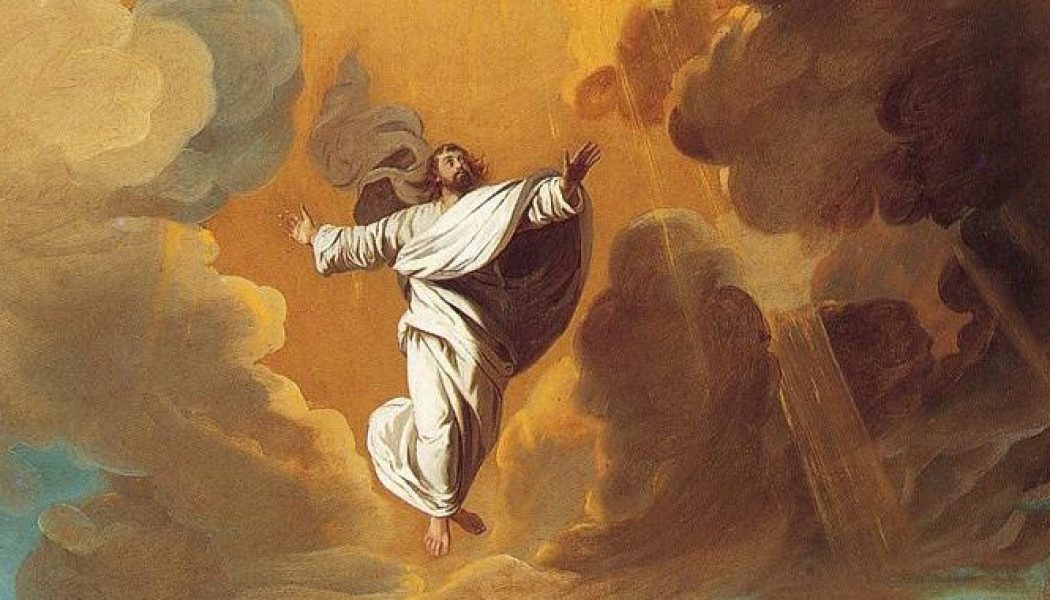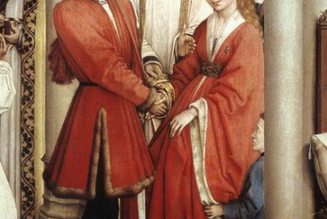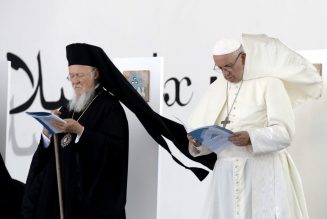
Certain mysteries in the life of the Church and certain beliefs and practices can become obscure over time, for a variety of reasons. This is evident, I think, in the commemoration of the Solemnity of the Ascension of the Lord. One important factor behind this obscuring of the Ascension is how most dioceses in the United States have transferred this feast day from its traditional position on Thursday—forty days after Easter—to the following. It’s a move that undercuts Scripture and Tradition. Secondly, the feast’s full significance can often be blurred or overlooked because it falls within the end of the Easter season and the upcoming feast of Pentecost.
A third, less obvious but also important, factor that can obscure the Ascension is certain modern biblical scholarship. Scripture scholars such as Robert Bultmann have stated:
What meaning …can we attach to such phrases in the creed as ‘descended into hell’ or ‘ascended into heaven’? We no longer believe in the three storied universe which the creeds take for granted…no one who is old enough to think for himself can really take seriously the fact that there is a God who lives in a local heaven for there is no longer any heaven in the traditional sense of the word. The same applies to hell in the sense of a mythical underworld that exists beneath our feet.i
Such a theological tendency, articulated in Bultmann, can lead in both the academic and popular realms to an undercutting of the full significance of what Jesus does for us in the paschal mystery. Denying the physical and historical nature of the Ascension can feed ideologies that strip Christianity of her divine element. This denial risks dividing the social teaching of the Church from her mission to evangelize and save souls. Such a divide then reduces her mission to secular activism and atheistic humanism, as seen in various neo-Marxist movements and community organizing movements that use groups of people as a political force for change without authentically willing their overall good.
To counter the influence of such a viewpoint, other theologians such as Joseph Ratzinger, encourage us to look at the actions of Jesus in the Scriptures and to more deeply contemplate their meaning in order to better understand the significance of the Ascension.
In the account from the first reading of the Feast of the Ascension, we hear the following:
When they had gathered together, they asked [Jesus], “Lord, are you at this time going to restore the kingdom to Israel?” He answered them, “It is not for you to know the times or seasons that the Father has established by his own authority. But you will receive power when the Holy Spirit comes upon you, and you will be my witnesses in Jerusalem, throughout Judea and Samaria, and to the ends of the earth.” When he had said this, as they were looking on, he was lifted up, and a cloud took him from their sight. While they were looking intently at the sky as he was going, suddenly two men dressed in white garments stood beside them. They said, “Men of Galilee, why are you standing there looking at the sky? This Jesus who has been taken up from you into heaven will return in the same way as you have seen him going into heaven.” (Acts 1:6-11)
We see that the actions of Jesus at his ascension into heaven culminate with “the irreversible entry of his humanity into divine glory, symbolized by the cloud and by heaven, where he is seated from that time forward at God’s right hand.”ii Pope Benedict XVI describes how the cloud is an element that presents Jesus’ departure “not as a journey to the stars, but as his entry into the mystery of God. It evokes an entirely different order of magnitude, a different dimension of being.”iii
Saint Thomas Aquinas also notes that although Christ ascends by the power of His own person into Heaven, “he was raised up and taken into heaven by the Father, since the Father’s power is the same as the Son’s.”iv This shows the divine intimacy that Christ as God the Son has with God the Father as well as his obedience to the Father in all things as He already showed in His passion.
The Ascension of Jesus is reveals that while our existence necessarily involves this present world, it most certainly does not end with this present world. The ultimate purpose of each human person is divine union with God who is Father, Son, and Holy Spirit. The entirety of the paschal mystery of Jesus culminating with his ascension into heaven makes this possible. This mystery of our salvation and sanctification in Jesus Christ is at the heart of the life, mission, and identity of the Church.
The Catechism reminds us of this truth where it states:
Left to its own natural powers humanity does not have access to the “Father’s house”, to God’s life and happiness. Only Christ can open to man such access that we, his members, might have confidence that we too shall go where he, our Head and our Source, has preceded us.v
In his passion and death on the Cross on Good Friday, Jesus paid the debt that we owed to God the Father for our sins. In his Resurrection from the dead at the tomb on Easter Sunday, Jesus elevated and restored our human nature in body and soul from the effects of sin and death. The Resurrection then brings every aspect of our nature as human persons back into harmony with grace—supernatural life—in this natural life. The Ascension of Jesus brings our existence as human persons into the depths what grace is: intimate divine union with the Holy Trinity in Heaven in the life of the world to come.
The Catechism further explains the significance of Jesus lifting up to heaven for us as connected to the rest of his passion:
The lifting up of Jesus on the cross signifies and announces his lifting up by his Ascension into heaven, and indeed begins it. Jesus Christ, the one priest of the new and eternal Covenant, “entered, not into a sanctuary made by human hands. . . but into heaven itself, now to appear in the presence of God on our behalf.” There Christ permanently exercises his priesthood, for he “always lives to make intercession” for “those who draw near to God through him”vi.
Just as seeing the world around us clearly is essential, so is seeing how every aspect of the Paschal Mystery is redemptive for us in unique and complementary ways. This interlinking of the elements of the paschal mystery is essential to maintain, just as is looking at its unique parts. By supporting this unity of faith upon the mysteries of the life of Jesus, particularly in the paschal mystery, we are aided in keeping our eyes on Jesus in the earthly journey of life so that we are not distracted by earthly projects, passing fads, or fleeting temporal gain.
The Ascension of Jesus reveals both the union of heaven and earth in the Incarnate person of Our Lord Jesus Christ. It also helps us develop a proper understanding of our own present moment in history. Too often, skepticism and atheistic trends found in unbridled secularism can tempt us to enter a certain self-referentiality, wherein we view life divorced from the mystery of faith and view our age as superior to that which came before it. This mindset can affect both secular life and the life of the Church to the point where we forget who we are in the eyes of God and our ultimate responsibilities to Him and our fellow man.
This self-referentiality that divorces the city of man from the city of God is at the heart of the cynical skepticism and outright atheism that the Church has struggled against for most of the twentieth century and in our current day in so many forms. How providential that this year, the Feast of the Ascension of Jesus falls on the one hundred and fourth anniversary of the start of the apparitions of Our Lady in Fatima, Portugal as well as the fortieth anniversary of the attempted assassination of Pope Saint John Paul II in Saint Peter’s Square. Both Our Lady of Fatima and Saint John Paul II knew well the damage such a disposition of atheistic communism can do to humanity in both natural destruction and supernatural darkness.
May the glorious ascension of Jesus into heaven as well as Our Lady of Fatima and Saint John Paul II help us to keep our eyes rightly fixed on the mystery of faith in this world so that we may soar to the heights and depths of its mysteries in the life that heaven imparts to us.
Endnotes:
i Rudolph Bultmann, Kerygma and Myth: A Theological Debate, ed. H.W. Bartsch, trans. R Fuller (New York, NY: Harper and Row, 1961), 4; Joseph Ratzinger, Dogma and Preaching: Applying Christian Doctrine to Everyday Life (San Francisco, CA: Ignatius Press, 2011), 311; Joseph Ratzinger, Introduction to Christianity, (San Francisco, CA: Ignatius Press, 1990), 237-239; Douglas Farrow, Ascension and Ecclesia: On the Significance of the Doctrine of the Ascension for Ecclesiology and Christian Cosmology, (Grand Rapids, MI: William B.Eerdmans Publishing Company, 1999), 18, footnote 15.
ii CCC 659
iii Benedict XVI, Jesus of Nazareth – Holy Week: From the Entrance into Jerusalem To the Resurrection, (San Francisco, CA: Ignatius Press, 2011) 282.
iv Thomas Aquinas, Summa Theologica, IIIa, q. 57, a 3. Ad I; Cf. Reginald Garrigou-Lagrange, Christ the Savior: A Commentary of the Third Part of Saint Thomas’ Theologica Summa, (Saint Louis: MO: B. Herder Book Co., 1950) 671.
v CCC 661.
viIbid, 662
If you value the news and views Catholic World Report provides, please consider donating to support our efforts. Your contribution will help us continue to make CWR available to all readers worldwide for free, without a subscription. Thank you for your generosity!
Click here for more information on donating to CWR. Click here to sign up for our newsletter.
Join Our Telegram Group : Salvation & Prosperity









